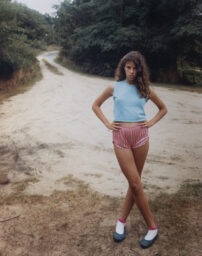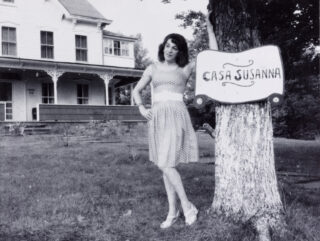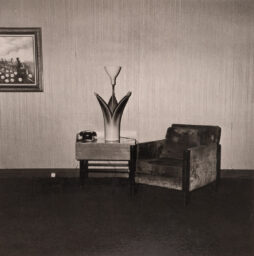Jeff Wall and Lucas Blalock: A Conversation on Pictures
Jeff Wall’s photographic work made over four decades has opened up the parameters of the medium to issues long understood to be outside its provenance. At the same time, his prolific writing has been an important factor in the development of a much-needed critical vocabulary. Wall’s contributions in both arenas provide conceptual underpinnings for contemporary artists. He requires photography to do the work of reflecting not only the world, but also the terms of that engagement. And his explicit relationships to both painting and film have opened new paths of understanding photography’s possibilities and place in the world. Wall makes use of a form of “cinematography” to pry photography from the narrow confines of technique and definition. His coinage phantom studio proposes that any given location can be imbued with the intentionality of the studio. These concepts and others have shaped the way we think about photography. In the conversation below, Wall speaks with Lucas Blalock about the current state of the medium, his recent work, and the freedom of the artist.
* * *
Lucas Blalock: Considering the changes that photography has undergone in the past decade, how might we consider it as a “medium” in its current situation? I mean here not the physical support, but the set of conventions or historical uses that act as a ground, making the decisions of the photographer legible.
Jeff Wall: I cling to the notion of photography as a medium insofar as it is an authentic way to achieve what we can call “the picture.” The physical nature of any medium has never been free from the conventional—and therefore historical—manners in which the physical elements have been handled. So I don’t feel there is anything particularly new happening in photography in that regard.
LB: You have written about the idea of “emphatic picture making,” which I think provides a compelling structure for thinking about photography. Could you talk about what you mean by this idea of the “emphatic”?
JW: “Emphatic picture making” is a phrase that I think expresses how photography can be free just to be an art form. Sculpture, painting, drawing, and the other older visual arts freed themselves this way a long time ago, but photography is still tied up with the practicalities of image production, and it’s hard for a lot of people working with it to achieve some sort of distance from that almost overpowering identity.
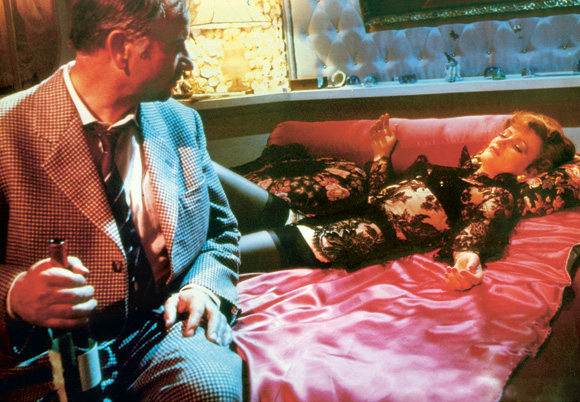
Still from Rainer Werner Fassbinder’s Lola, 1981. United Artists/Photofest
I’ve been criticized over the years for the perceived artificiality of some (or even most) of my pictures, for their apparently unwarranted, overcooked, and roundabout relation to the actualities of life—things that can be addressed much more immediately by remaining “true to the nature of photography.” But I like photographs that don’t look altogether the way photographs are supposed to look. We don’t really know how photographs are “supposed to look.” The existing conventions make it seem that we do, because they are authentic and central to photography, but they cannot predict what the next interesting photograph is going to look like. Nobody claims to be able to predict what the next good painting will look like.
LB: Lately we have seen the reemergence of a more literal “ studio picture,” and the photographer’s studio itself as the site of looking and picturing. The studio is being used by some artists for its particular conventional attributes: as a site with a specific history and the possibility of a kind of play on genre images (still lifes, commercial pictures, and so on). Do you find the work of artists like Christopher Williams, Roe Ethridge, or Michele Abeles to be in dialogue with your own thoughts on making studio pictures in the 1970s, or related to your “phantom studio” work of the past few years?
JW: A studio is a set of relationships, not so much a specific kind of interior—it doesn’t have to be an interior at all. But it can manifest in the kind of workspace that’s traditionally been used as a studio by photographers, or painters, or sculptors. There is no reason to view that kind of workroom as obsolete, as it seemed to be a few years ago, when everyone was excited about “post-studio art.”
Today the studio is not thought of in the binary, polarized sense that tended to prevail in the period when documentarytype photography was the norm, when the studio was defined as an artificial environment somehow not part of the real life that real photographers hunted and captured. That polarity was affected by the cinema of the 1960s, ’70s, ’80s—filmmakers such as Rainer Werner Fassbinder, Jean-Luc Godard, Pier Paolo Pasolini, and Ingmar Bergman could move from extreme artifice to moments of apparent documentary immediacy within a few seconds. Now we recognize the studio as a site of actuality no different in principle from any other site.
LB: In your 1993 essay on the Japanese artist On Kawara, you talk about how, in painting, the attraction to “lower”-genre pictures in the early modern era was understood as a movement toward the freest space, that these kinds of pictures are particularly good at “permitting a picture to be seen as a picture.” Can we look at contemporary photographic practice through a parallel lens? Do you think that there is a certain kind of work that these minor-genre pictures are particularly suited for?
JW: As photography becomes more and more familiar with itself as high art, and in some sense begins to be absorbed into the whole idea—the institution—of high art, photographers seem to be able to go through the same sorts of dialectics that painters and sculptors went through in the past century. In the nineteenth and twentieth centuries, “lower”-genre pictures were less constrained by the social and cultural ambitions that were woven into the structure of the higher types, so they became a less-delineated space in which a process of experimentation took place. Photographers were aware of this, and to some extent responded to it. But since there were no real “high” genres of photography back then, there wasn’t the intensity of engagement that there was in painting. Maybe now that there are apparently high genres in photography, the situation has evolved to the point at which it is possible to respond to their presence by moving away from them and, to an interesting degree, repeating aspects of what happened in painting a hundred or more years ago.
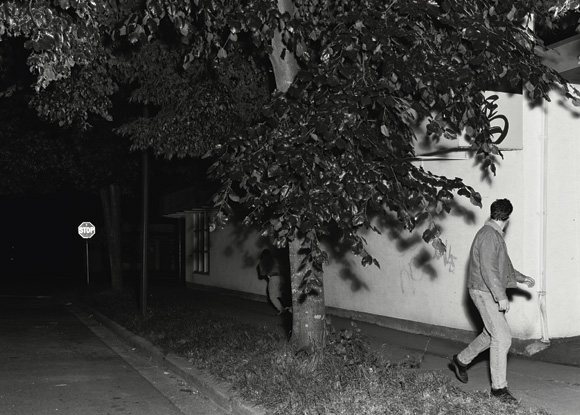
Jeff Wall, Passerby, 1996. Courtesy the artist.
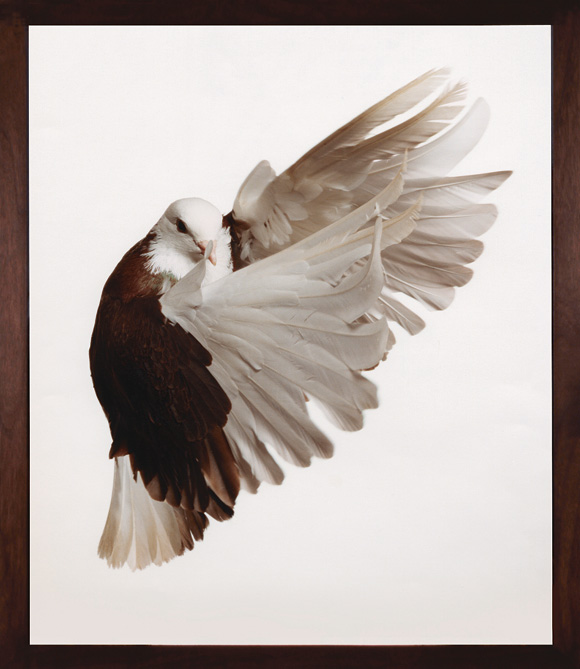
Roe Ethridge, Pigeon, 2001. Courtesy the artist and Andrew Kreps Gallery, New York.
But it looks like people are trying to extend the sense of what permits a something to be seen as a picture—that is, with an ambition to matter in terms of proposing what a picture is at its most significant level. Younger artists (and some older ones, too) seem to be testing out this dialectic of higher and lower genres. The engagement with what have often been seen as trivial and compromised studio types—like the still life that started out as a commercial product photograph—seem to have to do with finding those little voids in the canon that can still disturb the consensus of what is worth bothering to photograph in the first place. This whole direction is really complex and sophisticated, and has been an undercurrent throughout the history of modernism. It became “ problematic” when product photography had evolved to the point where, vampirically, it almost destroyed the genre of still life, in the 1920s.
LB: Interestingly, the same period saw the rise of commodity culture, which was arguably made possible by the cheap circulation of photographic images. I wonder if this is in part because objects again have a central role in this stage of capitalism, a role that will eventually be subsumed by the abstract strategies of brands and identity marketing. And, in an increasingly digital environment, commodity objecthood—once seen as a tremendous abstraction and mode of distancing from the world—can now be seen instead as a connective possibility.
In the digital age, images are infinitely transferable, editable, and contiguous with their surroundings. They relate as much to the bodiless virtual archive as to the “having-beenseen” of the camera’s subject. To me, this is a new problem for a picture.
JW: That’s interesting—the idea that the network of electronic image traffic has become present in the relation between the photographer and the picture he or she sees in a viewfinder. But I think that that is true if you want it to be, not in itself. Because image traffic has become so heavy and so continuous, it now seems as if these millions of images came into being by themselves, without the agency of a person. And in a certain percentage of them, it’s true, because a lot of images are now made robotically and circulated automatically.
But that is more about the experience of seeing images than of making them. Artists have been fascinated by the notion of imitating a robot since the emergence of machines. But it is a willful imitation, an individual decision, not caused by the nature of the economy or technology. This is a good moment to look once again at the old idea of artistic freedom. In this context, artistic freedom means the awareness that as an artist you can choose your relation to the technologies; none is imposed on you the way it would be if you were an operative in an automated image-generating system of some kind. You cannot point to any institution that requires this or that behavior from you—art can be anything now.
Your own pictures, Lucas, show a sort of angst about this disembodiment—there’s an almost expressionistic aspect to the rough handling of the digital information. That does make them resemble paintings or prints … and you’re aware of this and very into it. You could say that your angst is your take on a social condition, and you’d be right about that. But there’s no social necessity to respond to social conditions artistically this way or that. There are no rules for this, so another artist could just as legitimately respond in a very different manner. All we have to compare between them are the results. And your results can be art of the highest quality, and mine, which could come from a completely different and even dissenting take on the same social material, could also and simultaneously be art of the highest quality, and both could be in touch with some true state of that same social material at the same time, but other to each other. So, to answer your question “Is this disembodiment a new problem for the picture?”—yes, it is a new problem if you need it to be one. If you need to ignore it and pretend it isn’t happening, you might get laughed at socially, but there’s no way to claim that that, probably childish and neurotic, act cannot lead to something artistically significant and first-rate.
LB: I want to ask about a shift I have felt more generally in the last decade from a discussion about photography modeled on cinematic tropes to one that is ostensibly based in painting. I feel like your work has long been a bridge across these two models and am curious to know if you have felt that this realignment has impacted your practice. You have said that some of your recent pictures were made in a “more pronounced” way, and I wonder if that might relate to this discussion.
JW: The relationship of photography to cinema and painting has always been the important thing for me. If it is just painting, then you fall into the situation that’s been so constantly criticized over the decades—that you are betraying this medium in the name of another one. If it’s cinema, you’re relegated to being commentary on the more complex results of another medium that therefore seems more powerful, and predominant, than it really is. It could be that at the moment artists are drifting further in the direction of the painter’s studio and métier, away from either cinematography or the documentary style. But there is a wide band where you’re in touch with all three elements even if you’re tending toward one or another pole.
My take on it has been that photography as art is constituted by this complex interrelationship between the documentary root, the cinematographic, and the kinship with the other, manual, depictive arts. This is a very large and high-energy entity; it’s not swamped by the vast “social” identity of photography—I mean, the aspects that aren’t art. It is almost magnetically attracted to them, because they aren’t art. As we know, art needs non-art in order to recognize itself. So I’m not aware of realignment because I feel that the domain is so large and internally various that one can shift this way and that and not really go anywhere radically different. I spent quite a bit of time over the past ten years or so exploring a kind of “near-documentary” picture, one that resembled snapshots or documentary photos. That was something I really wanted to do consistently, for a lot of reasons—the main one being to find out what that kind of picture actually looked like. And now more recently I’ve felt the need to diverge from that and try to make pictures that are more emphatically pictorial. I’m tired of struggling with a certain kind of problem, but the result of that struggle is that I find myself in a different spot, with a different relation to “near documentary.”
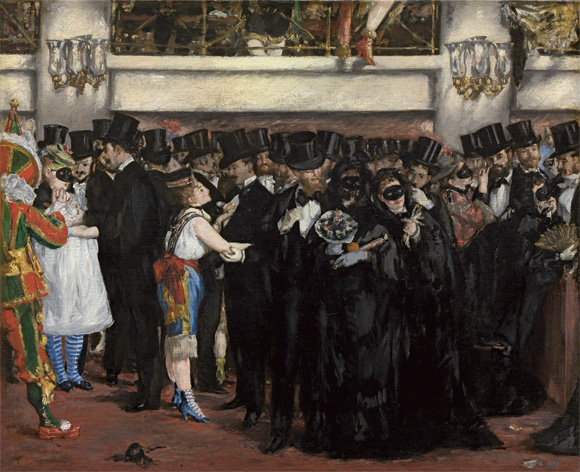
Édouard Manet, Masked Ball at the Opera, 1873. Courtesy National Gallery of Art.
LB: That reminds me of Garry Winogrand’s remark that he made photographs “to see what things looked like photographed.” Although I think that the character of Winogrand’s statement actually has a very different inflection. To make pictures that make a something—the thing pictured—be seen not only as itself but as a picture of itself sets up a certain kind of problem.
JW: A few years ago I wrote a short essay on Édouard Manet’s 1873 painting Masked Ball at the Opera. I noticed it seemed that Manet created a particular amount of space between his own position and the large group of people at the masked ball. That gap could easily have occurred in real life—anything can occur—but, still, what he did was interesting. I thought he insinuated into the social event he was depicting the kind of space that would almost naturally exist between a painter and a model in a studio situation. He created a subtle bracketing of the immediacy of what he was depicting by stepping back ever so slightly. He could not deny himself the excitement of making the most complex event hover with a very slight sense of suspension, in the form of the tableau—that form that can absorb and arrest any and every event once it becomes a picture.
I find this pictorial structure itself so suggestive and rich because it transforms the thing it depicts in the process of depicting it, of recording it. The “motif,” the thing depicted, comes to life not because of its own liveliness—even though it has that, too—but because of the way it almost vanishes into the tableau. The tableau-form, like a magic substance, both records with great fidelity and transforms the thing to which it is being true into another thing: a picture.
LB: You have used the term occultation in connection to similar ideas, and I’d like to get at the relationship between the “occulted” picture and the notion of immediacy. Please correct me if I’m wrong, but the immediate here is a presentation of the world that tries to suppress its qualities as a picture. The advertising image or the swimsuit photo might be good examples; an image depicting the seamlessness of technology might be another. I want to press this question of immediacy because it is potentially a defining characteristic of our time. I feel like, from this vantage, the dull, the boring, and the unspectacular have in turn been imbued with a lot of promise.
JW: Occultation was a term used by André Breton, I think in the Second Manifesto of Surrealism in 1929. He meant it partly in the sense of getting serious about the turn to myth and esotericism. But there was also a side of it that had to do with moving artistic work away from direct engagement with public matters and with “the public” as such in favor of a radical idea of artistic experiment, but also of artistic seriousness. Art that took into account the expectations of the public and of the existing domain of convention and taste was seen as compromised and kitsch. This attitude originated before Breton, with the Romantic and Symbolist poets, and it carried over into the New York School and the attitude toward seriousness and “high art.” It’s part of a long, and I hope still meaningful, tradition or lineage that expects art to dissent from conventional artistic taste at any given time, for all the well-known reasons, and to dispense with the idea that it is necessary to be popular in any way to be significant and even to be successful.
I have tried to practice photography in intense empathy with that, though not always in the same way. There is no one kind of “ serious” art. Fassbinder’s work is “occultish” to me even though he parodied and pastiched popular genres and styles. It’s the way he did his pastiche that gives his films their occulted feeling. It might not be something you can point to precisely and identify but it is there. On the other hand, Mark Rothko’s paintings are examples of the grand style of occultation. They are “ classic,” where Fassbinder is “mannerist,” but both are great—and they are akin somehow because they are great. In both you are looking at something that never occurred, did not exist, but has been made visible nevertheless. There is therefore a feeling of emanation, of something surfacing; the surface is coming into being, into visibility, not as a response to an existing surface, a social surface. And when a something surfaces as a picture, it can’t be dull or boring—no matter the subject.
—
Top image: Photograph of Jeff Wall by Greg Girard, October 2012 (detail).
Jeff Wall’s photographs have been exhibited internationally, and his critical writings have been widely published. The most recent of Wall’s retrospective exhibitions was presented at the Museum of Modern Art, New York, in 2007. He has received many prizes, including the Hasselblad Award for photography in 2002. He is based in Vancouver.
Lucas Blalock is a photographer and writer who lives and works in Los Angeles.




















